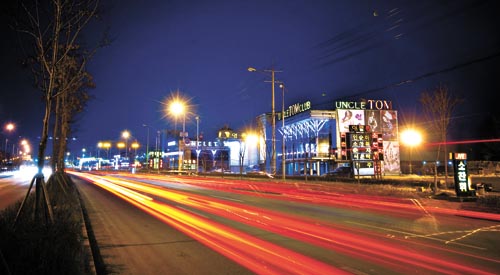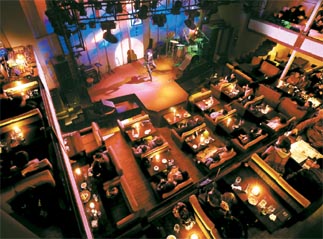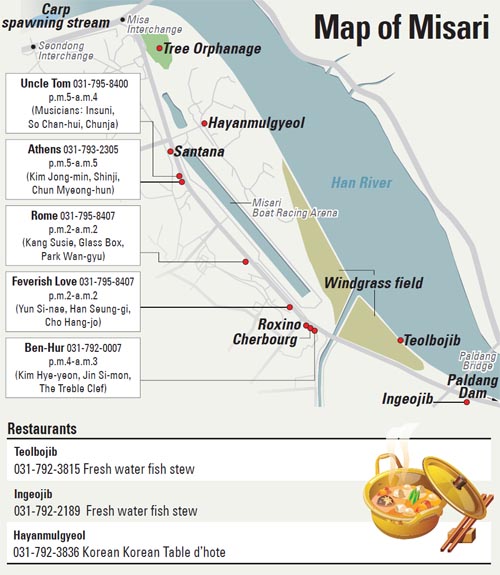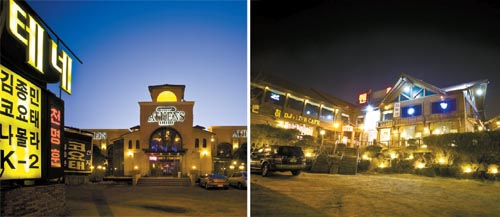Misari harkens back to era when folk was cool

Uncle Tom is one of five live cafes that remain in Misari, Hanam City. By Kwon Hyuk-jae
On the eastern banks of Han River, there is a small village where the memories of Koreans who had their heyday in the 1970s and 1980s - widely dubbed “7080 generation” - still linger.
The place known as Misari occupies Mangwol-dong and Changwu-dong in Hanam, Gyeonggi.
Live cafes that were established in the area in the late 1990s are the successors of live music halls that had been scattered in Myeong-dong and Mugyo-dong, central Seoul, in the 1970s.
At Misari’s peak in the ’90s, dozens of live music cafes competed to attract high-profile folk singers to the point where they charged up to 30,000 won ($26.91) for a cup of coffee to pay the performers. But after prices rose, once-loyal customers turned away. The decline was precipitous: only five of the cafes exist in an area where more than 60 once stood.
The famed Roxino cafe - where legendary folk singer Song Chang-sik used to sing - turned into a restaurant. Cherbourg, where the legendary DJ Lee Jong-hwan used to spin records, has been converted into a Thai massage parlor.
Santana, where singer Lee Chin-hyun often performed to a packed house, has become a Chinese restaurant.
Rejuvenation

Youngsters tend to prefer Uncle Tom and Athens, whereas the older generation is the major clientele at Rome, Feverish Love and Ben-Hur.
Misari has also long been a popular tourist destination for Koreans who have lived abroad for years. “I have taken my relatives living overseas all around Korea, but they say the most memorable place we went to was Misari,” said Ji Seok-sun, 54, a homemaker.

People begin swarming into the Misari area from around 9 p.m., when popular singers take the stage.
At Feverish Love, a middle-aged audience crowds into the small space every weekend waiting for Yoon Si-naeh. Yoon is a husky-voiced singer who was immensely popular in the 1970s and 1980s.
Misari’s live cafes take the form of small theaters that enable equally good views from all seats.
“Only cafes that provide quality service have survived,” said Oh Gyun-ah, owner of Feverish Love.
Lee Chul-hee, director of Uncle Tom, said live cafes targeting youth tend to feature young singers. “Many of the singers are not very well-known, but some of them have their own fan base here,” he said.
Misari, though not nearly as popular as it once was, isn’t for the tight-fisted. Prices for drinks in cafes here are high - ranging from 17,000 won to 25,000 won. Spaghetti and steak cost between 25,000 won and 50,000 won, but there is no cover charge for the live music. Prices do rise on the weekends when more popular singers perform. But most visitors seem undeterred by the prices, saying it is relatively cheaper than concerts or dinner shows.

These days, Misari has branched out from its dependence on live music cafes. There are a number of unique destinations worth visiting.
In a part of the Han River called Seondongdunchi, named after the nearby Seondong intersection, schools of carp spawn every April.
Over the summer, Tree Orphanage is worth a visit. Located between Misa Road to Misa Bridge, trees have been replanted here. Signboards in front of the trees tell their story; some were originally planted at a military camp, and when arborists arrived one day to uproot them, the men were carted off to a military inspection center for questioning. They apparently failed to go through the proper procedures.
During the summer, the rising river discharges water through floodgates at Paldang Dam, making for a spectacular scene.
In the fall, a silver grass field stretches across the eastern end of the Misari Boat Racing Arena.

Misari’s most popular food is a hot stew called maeuntang that is made with freshwater fish. Before the cafes took over in the 1970s, a slew of restaurants serving raw fish and maeuntang dominated the area. But a 1999 law banning fishing in the Han River was a death knell for most of the restaurants.
Among the few that remain, Teolbojib and Ingeojib are the most popular. Both charge 40,000 won for one pot of maeuntang made of different freshwater fish, which is enough for two people. A high-end maeuntang with mandarin fish costs 70,000 won.
Between Misa Road and Misari Boat Racing Arena, Hayanmulgyeol is well-known for its Jeolla-inspired dishes. Its lunch special includes cockle from Beolgyo, South Jeolla, ddeokgalbi and dried yellow corvine from Yeonggwang, South Jeolla. It costs 17,000 won per person. A full-course dinner is priced at 58,000 won. Hayanmulgyeol is open from 11 a.m. to 10 p.m.
By Lee Jeong-bong [spring@joongang.co.kr]
Related Korean Article[중앙일보]
미사리 라이브는 살아있다
서울의 동쪽 한강변에 ‘7080세대’의 추억이 살아 숨쉬는 작은 마을이 있다. 경기도 하남시 망월동과 창우동 일대다. 사람들은 그곳을 ‘미사리’라 부른다.
1990년대 후반 미사리에 들어선 카페촌은, 이제는 추억이 된 70년대 명동·무교동 음악감상실의 적자(嫡子)다. 쪽의자에 앉아 장발의 디제이가 틀어주던 그 노래를 라이브로 들을 수 있는 곳이어서 중년의 발길이 끊이지 않았다. 그 바람에 미사리는 70년대 청춘을 보냈던 이들의 추억이 살아 있는 꿈의 무대로 자리 잡았다. 추억을 더듬는 사람들로 불야성을 이뤘다. 요즘 ‘세시봉(C’est ci bon)’ 멤버로 인기를 끄는 송창식도 이 무대에 섰었다.
한때 라이브 카페 60여 곳이 불야성을 이뤘던 미사리는 현재 5곳만 영업 중이다. 수는 줄었지만 시설은 좋아졌다. 엉성했던 곳은 사라졌고 라이브를 즐기기 좋은 소극장 구조의 카페만 남았다. 지금은 옛 추억을 되살리는 중년뿐 아니라 젊은이들의 발길도 이어지고 있다.
한창 때는 라이브 카페 60여 곳이 성황을 이뤘지만, 몇 년 전부터 차츰 줄기 시작했다. 왕복 2차선 도로가 8차선으로 넓어졌고, 서울~춘천 고속도로가 뚫리면서 사람들이 떠났다. 카페끼리 대형가수를 유치하기 위한 경쟁이 심해지면서 3만원 이상으로 치솟은 커피 값도 손님이 발길을 돌린 이유였다. 송창식이 열창했던 록시노는 레스토랑이 됐고, 이종환의 쉘부르는 타이마사지숍, 이치현이 나오던 싼타나는 중화요리집으로 업종을 변경했다.
현재 라이브 카페는 5곳만 남았다. 중년들이 찾는 로마·열애·벤허와 젊은 층이 드나드는 엉클톰·아테네. 이제는 카페 ‘촌’이라 부르기에는 쑥스러운 숫자다. 하지만 아직 중년들의 발길은 이어진다. 거리는 예전 잘나가던 시절에 비해 썰렁하지만 라이브 카페 안의 분위기만은 여전히 열정적이다.
횟집이 늘어서 있었던 1997년의 미사리 풍경
사람이 들어차기 시작하는 건 오후 9시부터다. 이때부터 미사리의 인기 가수가 무대에 서기 시작한다. 로마는 유리상자·박완규, 열애는 윤시내·한승기, 벤허는 김혜연·진시몬 등이 등장한다. 윤시내가 노래하는 ‘열애’는 주말 밤이면 모든 객석이 중년들로 빽빽이 메워진다. 미사리의 라이브 카페는 대개 1·2층으로 나누어진 소극장 구조로 무대가 객석 어디서나 잘 보인다. 열애 오균아 사장은 “라이브 카페의 숫자는 줄어들었지만, 그만큼 수준 높은 곳들만 살아남았다”고 말했다.
요즘은 미사리를 찾는 젊은 연인의 수가 눈에 띄게 늘었다. 서울에서 가면 미사리 초입에 있는 ‘엉클톰’과 ‘아테네’는 젊은이가 주 고객이다. 이 두 곳에는 젊은이가 좋아하는 가수가 무대에 선다. 인순이·춘자는 엉클톰, 김종민·신지·천명훈은 아테네의 메인 가수다. 또 톡톡 튀는 입담과 화려한 댄스를 주로 하는 20, 30대 가수가 나오기도 한다. 엉클톰 이철희 실장은 “젊은 층을 타깃으로 하는 라이브 카페라서 젊은 가수팀을 쓴다”며 “이들은 대개 무명이지만 이미 팬클럽이 있고 평일에 이들을 보러 오는 팬들도 꽤 많다”고 말했다.










with the Korea JoongAng Daily
To write comments, please log in to one of the accounts.
Standards Board Policy (0/250자)